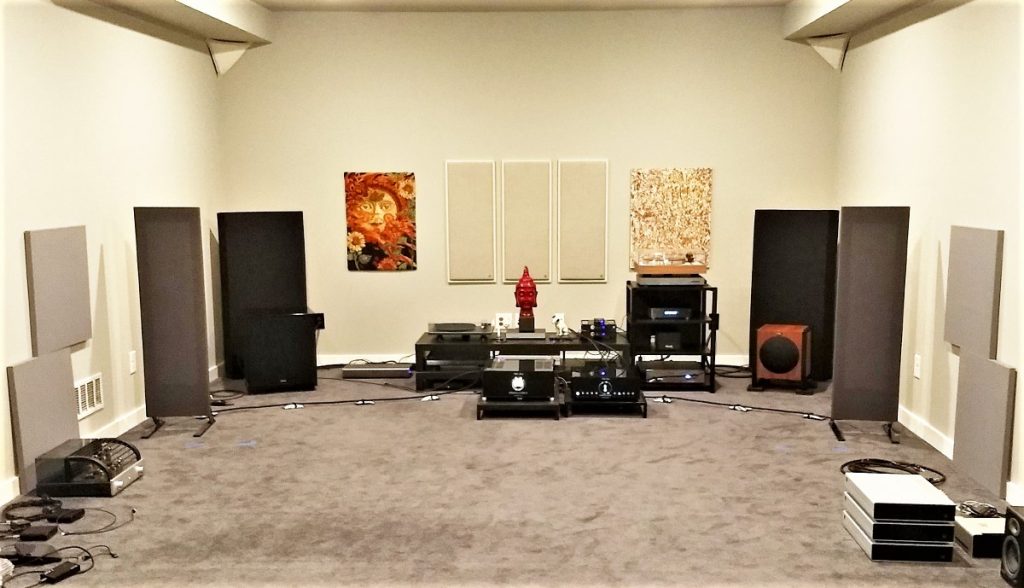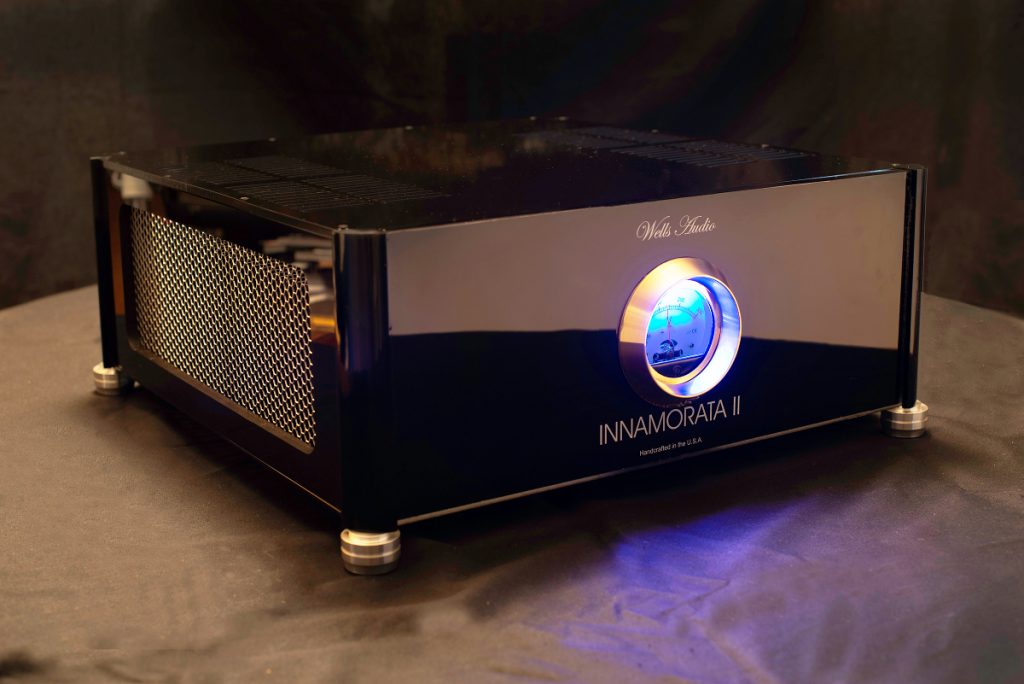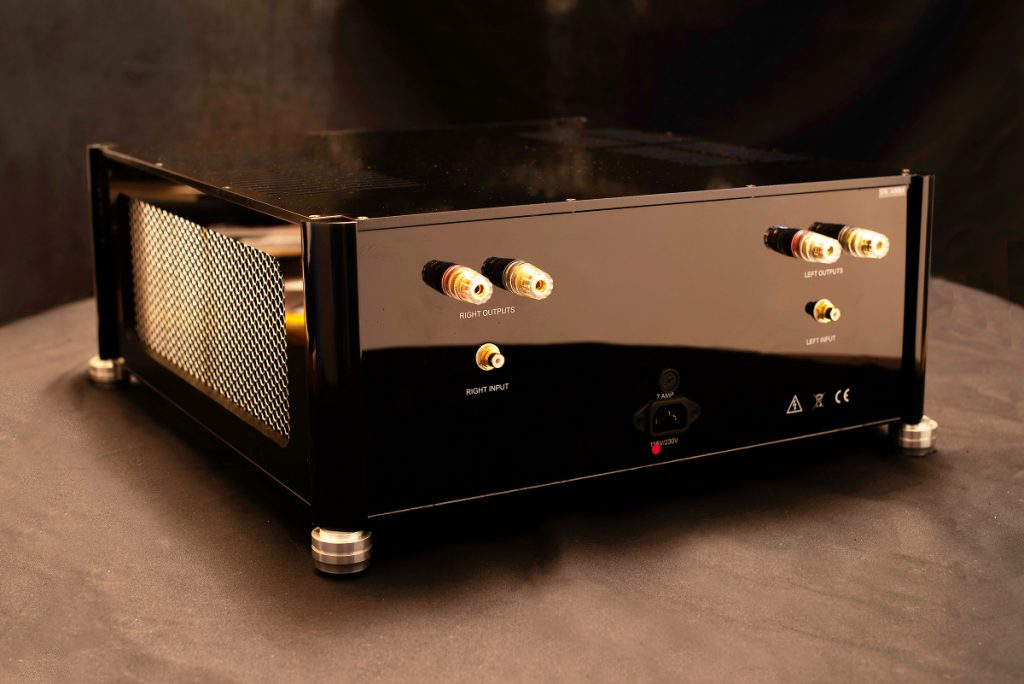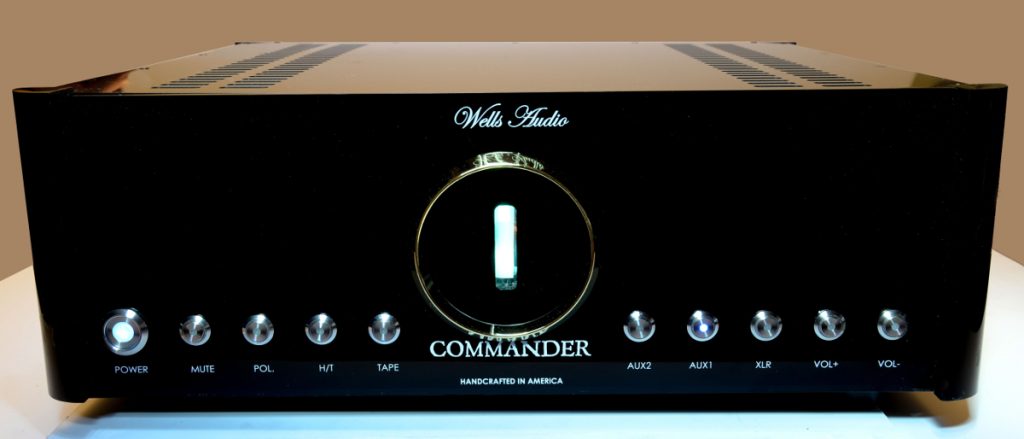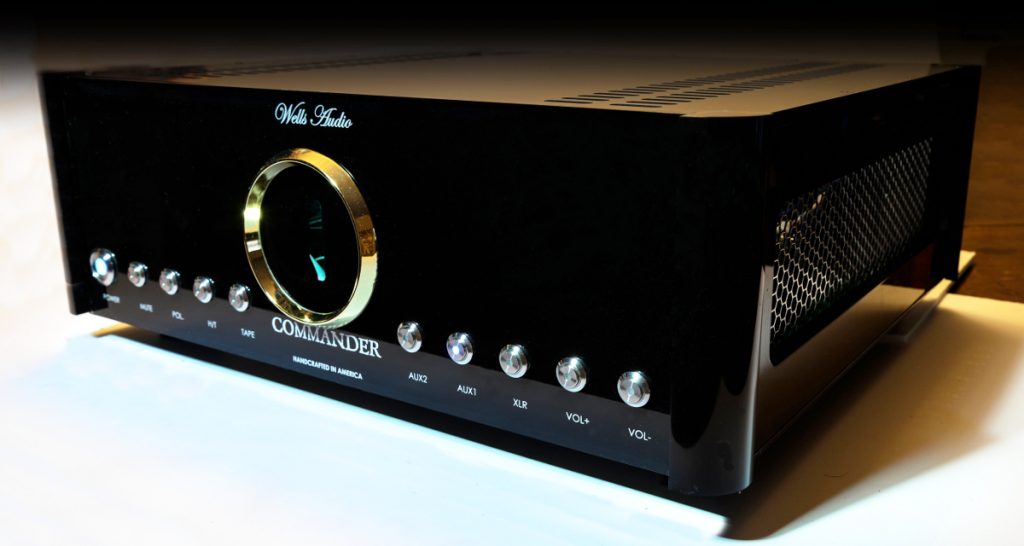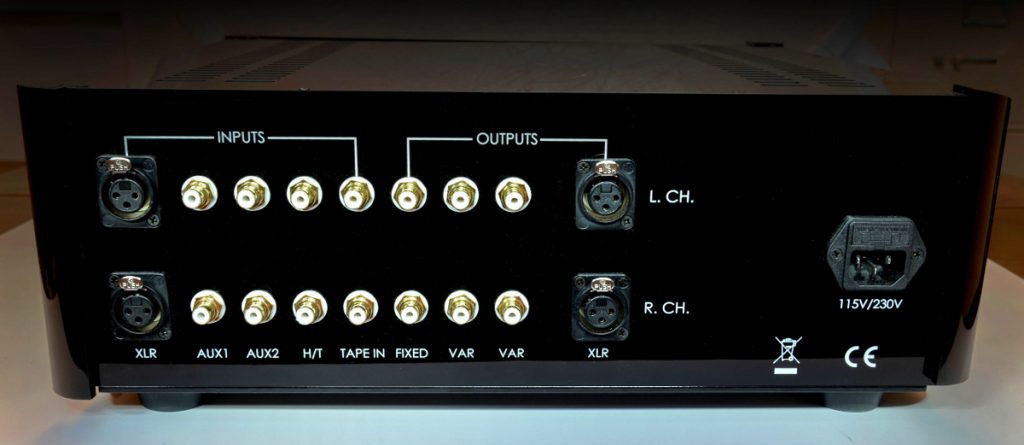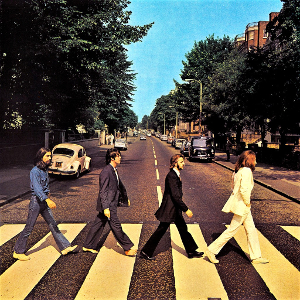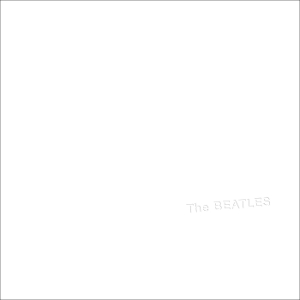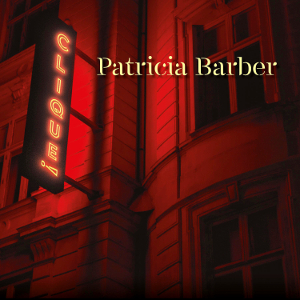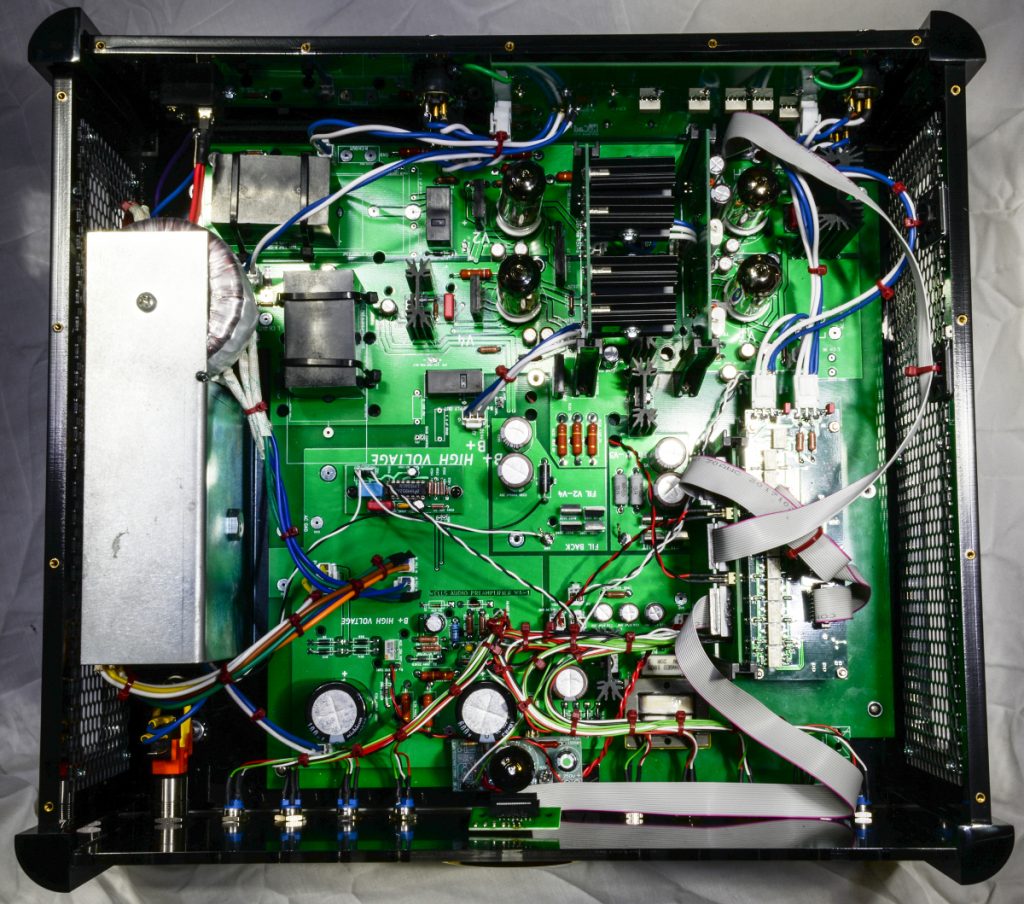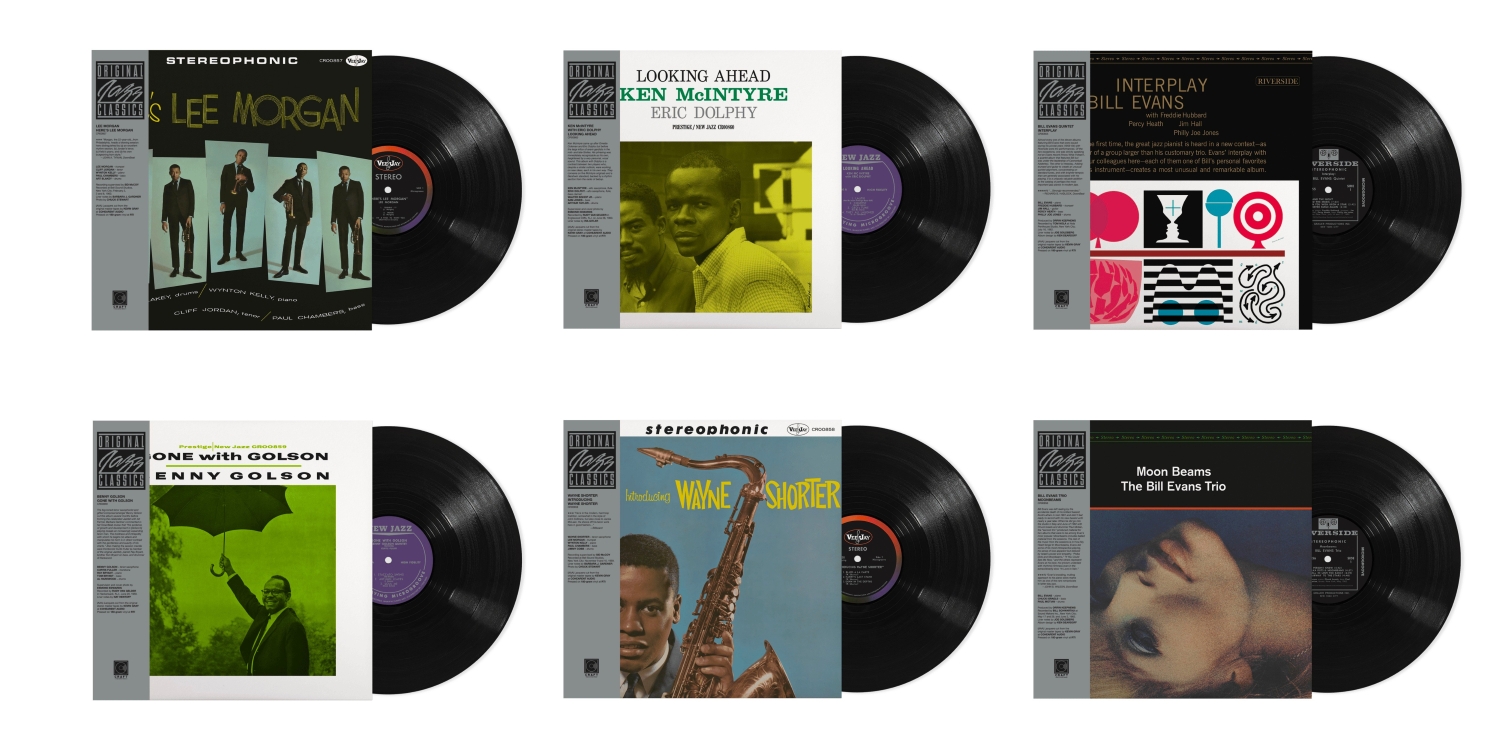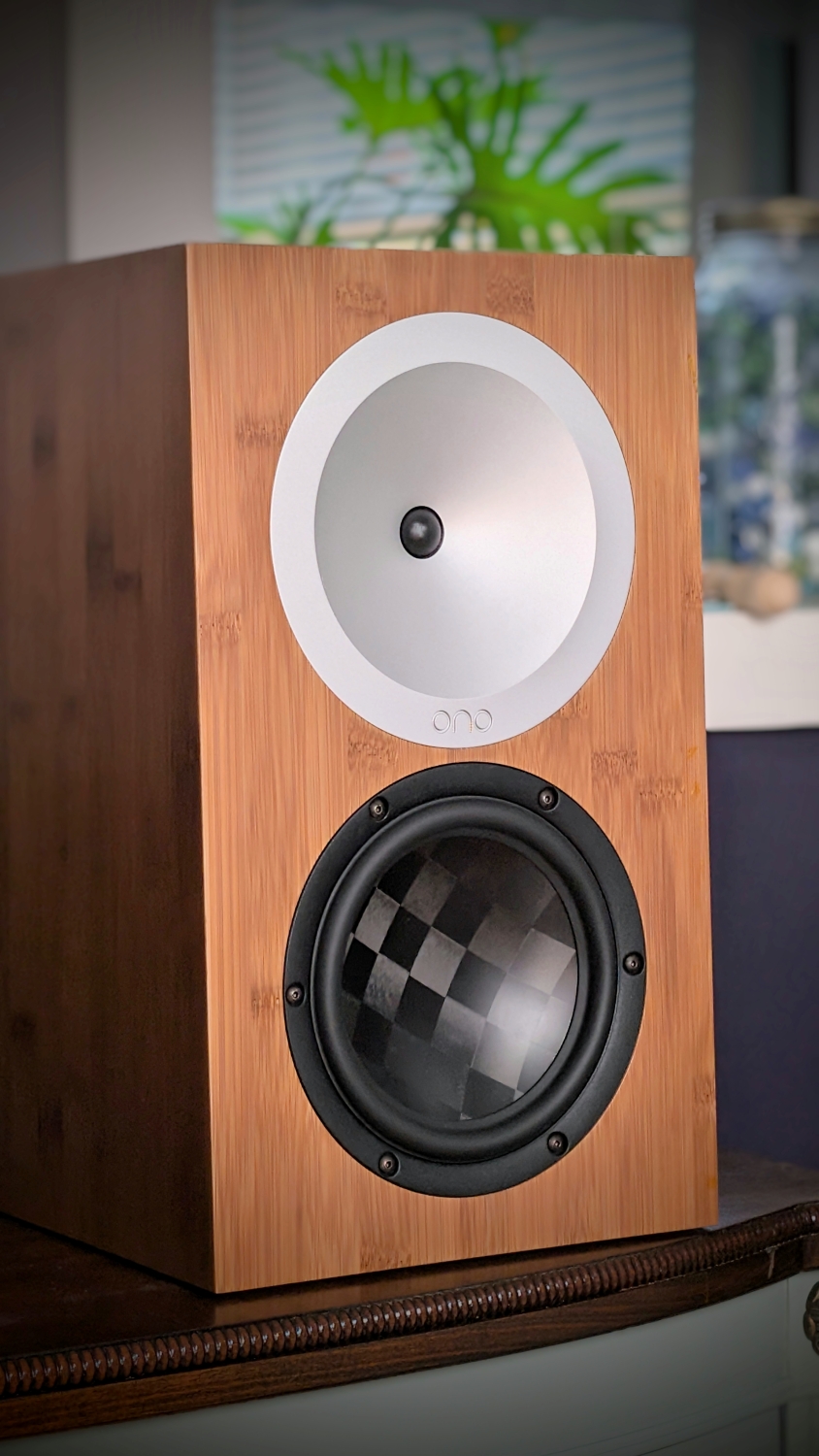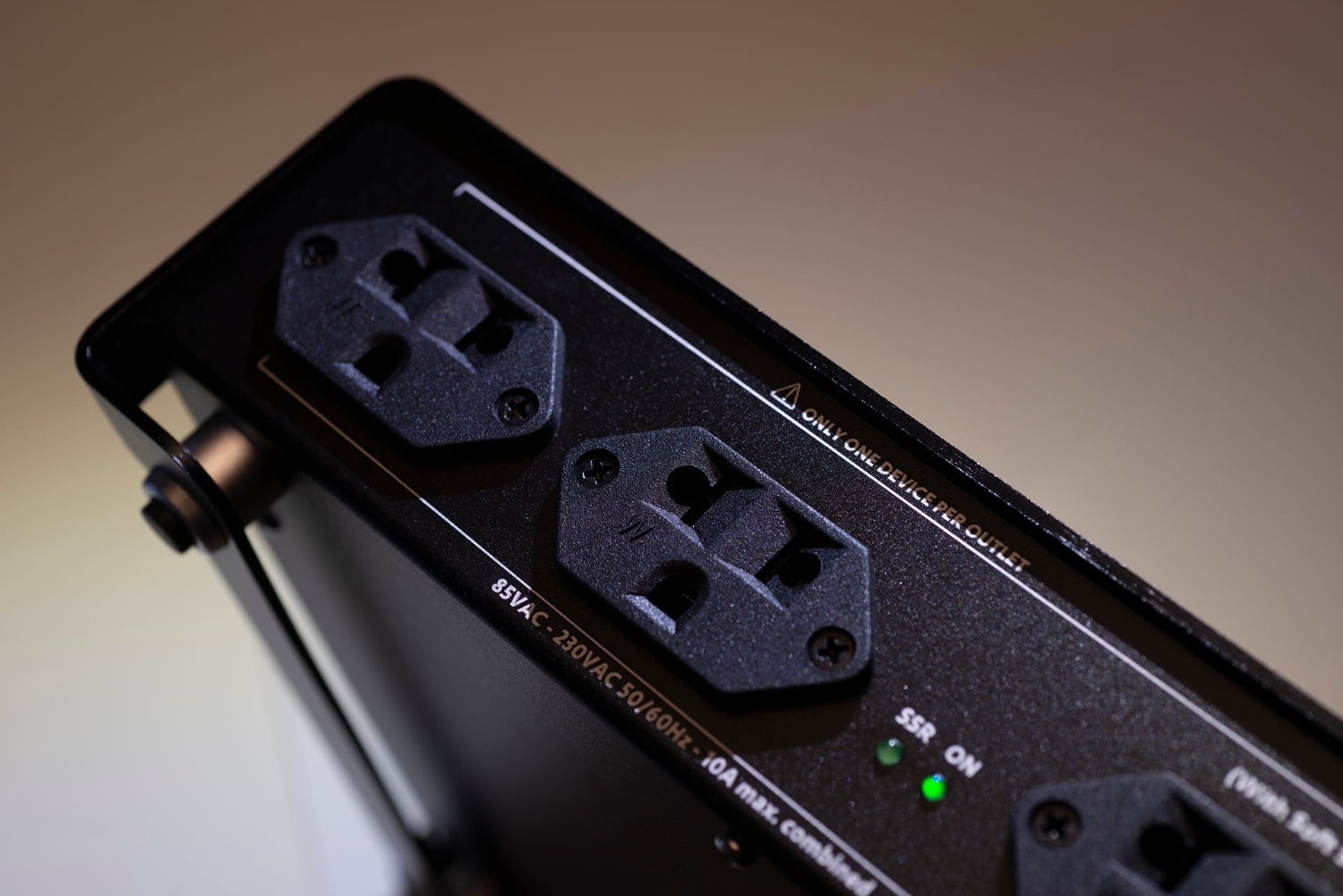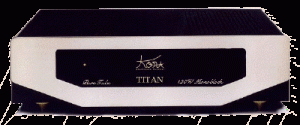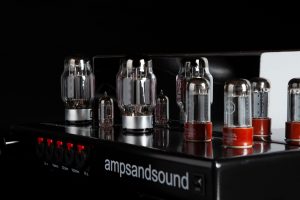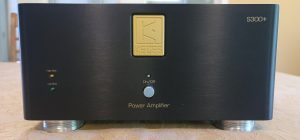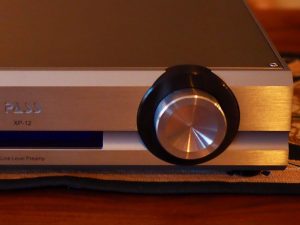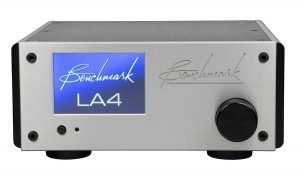Prologue
I've had the Magneplanar LRS loudspeakers in my daily-listening system for over two years now; every time I swap them out for something else, they invariably seem to find their way back in. And that's despite being devilishly difficult loudspeakers to drive; their 2.8 ohm impedance (almost constant across the entire audio spectrum) presents a tough load for all but the very bravest of amplifier designs. You have to trust me on this—I've already completely killed a couple of amps while driving them, and had several go into thermal protection mode—and that's with fairly modest and normal playback levels. The LRS is kind of like Linda Blair's character in the movie The Exorcist; a fairly innocent-looking child of a loudspeaker, but a demon from Hell when it comes to the demands it places on whatever's driving it.
When I originally spoke with Magnepan's Wendell Diller about a possible review of the LRS, he played them up as being very special at their price point—which they undoubtedly are, even though they're basically an entry level design. But he also pushed the angle that despite their low, low price ($650/pair), one of the design goals of the LRS was that it wouldn't be embarrassed alongside much more expensive, traditionally designed loudspeakers in a true high-end system. And would provide an opportunity for owners of those systems to explore the joys of the Magneplanar sound for nearly nothing with a loudspeaker that would perform admirably with cost-no-object electronics. And that taste of the Maggie goodness might possibly encourage them to later invest in Magnepan's more esoteric (and much more expensive) designs. With my total system clocking in at somewhere around about $40k or so, I took this all with a grain of salt; I knew I was definitely not the target audience for the LRS.
So my initial pre-impression was that the LRS was some kind of toy for the one-percenters, and while the rest of us would probably enjoy the trickle-down increase in performance, how great could it really, actually be? Well, in answer, words like total game changer come into play here; having lived with the LRS for two years, I've arrived at the conclusion that it represents a true paradigm shift in Magneplanar design. And that's based on 30-plus years of experience with six different Magneplanar models. If you haven't figured it out yet, I'm truly enamoured with the LRS, to say the least! It's a true classic among loudspeaker designs of any era; the simple fact that Magnepan can manufacture and sell them for only $650 is mind-boggling to me. The LRS is definitely range-restricted—it doesn't offer much in terms of bass below about 50 hz—but in my world view of things, the LRS deserves to be mentioned in the same conversations involving classics like the Quad ESL or the LS3/5A.
With all of that said, the problem remains—what exactly does it take to drive a tiny beast like the LRS? I've had outstanding results from Class-D designs from the likes of Bel Canto and PS Audio (the Bel Canto e1X that was in my system for a year retails for almost ten times the MSRP of the LRS!). And I've had good results with Class AB designs as well, although no amps in that class I've auditioned during the LRS's tenure in my system (Schiit, Emotiva) could remotely qualify as high-end. And I've had acceptable results with tube amplification, although my current go-to tube amp, a PrimaLuna EVO 300 integrated, just doesn't have enough juice to really power the LRS with any music that's more demanding than say folk, vocals, or acoustic jazz.
Wells Audio comes into the picture
That's where Wells Audio makes the scene; Jeff Wells and I had ongoing conversations regarding his amplifier designs, and he eventually decided to send both an amplifier and preamp to me for review. Jeff told me that he'd read my reviews of the Magneplanar LRS, and since his amps are designed to work well with loudspeakers that present difficult loads, he felt they'd be a really good match with the LRS. He'd be particularly excited to hear my impressions of the sound of his equipment, and I was really stoked to hear his flavor of high-end amplification with the exceedingly difficult LRS.
Jeff decided to send both the Innamorata II stereo power amplifier and the Commander hybrid-tube, line stage preamplifier, which are Wells' baseline kit. And probably come much closer to fitting into the "good sound on a budget" ethos that essentially characterizes my system and most of my reviews. He felt that the combination of the two would offer me a compelling illustration of Wells' signature sound, and would be a great starting point for my exploration of the Wells Audio experience.
Innamorata II Amplifier
The amp I received was the Innamorata II Stereo Amplifier, which at $7k is Wells Audio's entry level stereo amplifier. According to Webster's, Innamorata (of Italian origin) means (paraphrased to be more socially correct) "A [person] with whom one is in love with, or has intimate relations with…[one] who inspires you." On their website, Wells Audio asks the question, "Will you fall in love with one of the best amplifiers in the world?"
The Innamorata II presents a stunning visual first impression. It's large as amplifiers go, measuring 17.5" wide x 6" tall x 18" deep, and doesn't fit nicely (or at all!) on conventionally-sized amp stands. I happen to have a multitude of stands around for review purposes, and was able to get the amp reasonably well-placed using a pair of Target amp stands. The Innamorata II weighs under 50 lbs, and is surprisingly easy to manhandle, especially considering its overall girth. The outer case is finished in scratch-resistant piano gloss black cast acrylic (which is the same material bulletproof glass is made from), and the front panel sports a rather large voltage meter that's available illuminated in blue, green, or white. Each side panel is inset with a shiny silver metal screen that along with the perforations on the top panel provide effective ventilation for the case; during extended use, the case only barely got warm to the touch. The same gloss black cast acrylic covers the rear panel as well, which features a pair of clear, WBT-style 5-way binding posts, along with a pair of heavily-plated, single-ended input jacks. The power switch is located under the left edge of the front panel. The Innamorata II is fitted with shiny silver metal feet that provide a stunning accent to the piano gloss black finish. The stock AC power cord was replaced with an AudioQuest Blizzard w/DBS cord during the review process.
The Innamorata II is rated at 150 watts per channel into 8 ohms, and can deliver 210 watts per channel into 4 ohms. No published specification is listed for 2 ohm loads, but Jeff assured me that the amp would have no problem driving the LRS's 2.8 ohm rating. Although the Innamorata II is a Class A/B design, it's heavily biased into Class A, so most listening levels would probably be well within the amp's Class A rating. And the Innamorata II is the first audio design to use Bybee Labs' Music Rails and Quantum AC filtering, that achieves up to -45dB of DC noise reduction, which Jeff Wells describes as a revelation in terms of the amp's overall clarity of sound. The frequency response is rated at +/- .25dB from 10Hz to 50kHz, and the amp has a signal-to-noise ratio of -103dB referenced to full rated output. Rated THD is very low at .025% into 1kHz and .05% into 20kHz; both ratings are measured at 100 watts into an 8 ohm load. The amp provides 30dB of gain, and has an input impedance of 30k ohms. Damping factor is rated at 200 into 8 ohms, and the amplifier is available in a variety of standard operating voltages that should fit the needs of just about any user.
Commander Preamplifier
The supplied preamplifier was the Commander, which is a hybrid tube line stage model that clocks in at just under $4k. The same piano gloss black cast acrylic finishes are employed here, but the metallic feet are replaced with feet made of black rubber. The Commander is sized a bit more accommodatingly, at 16.75" wide x 6.25" tall x 15" deep, fits nicely on a single Target amp stand, and only weighs 20 lbs. The front panel also sports a large meter (its appearance is somewhat consistent with the one on the Innamorata II) that indicates when the preamp's tubes have reached their correct operating state.
Metallic push buttons adorn the front panel for power, mute, polarity, home theater bypass, and tape-in, as well as buttons for two single-ended input sources, an XLR input, and buttons to control the volume level. No control of channel balance is available; most of the front panel functions are duplicated on the stylish and compact metal remote. The side panels employ the same combination of black cast acrylic with inset silver metal screens for ventilation (as on the amplifier); the tubes heated the preamplifier significantly more so than the amplifier, but only such as is typical for tube preamplification. The rear panel is also fashioned from the piano gloss black cast acrylic, and along with the previously mentioned single-ended and XLR inputs, fixed and variable level single-ended outputs were present, along with a set of XLR outputs. As with the Innamorata II, I used an AudioQuest Blizzard w/DBS AC power cord during the review period.
As noted above, the circuitry employed by the Commander uses a hybrid tube design, with a single gain stage that features a pair of 12BH7A triode tubes. I won't go into all the technical aspects of the design; you can find that on the Wells Audio website HERE. The 12BH7A was chosen because it's an extremely linear triode design, with minimal high-order harmonics and a distortion spectrum that consists of a small amount of second-order harmonics. Wells Audio states on their website that the tube complement and hybrid design offers "pure triode tonality." A phase inverter stage and buffer has been created by using a pair of 12BH7 split-load triode tubes in combination with a high-power PNP transistor made by Toshiba—which is the same one used in the output stages of all Wells Audio amps. All stages in the Commander are direct coupled, and the unit uses a very high-tech and low-noise power supply. This definitely isn't your daddy's vintage tube preamplifier!
Setup and operation
Setup of both units was fairly conventional in terms of input and output connections; I used AudioQuest Yukon interconnects between the amplifier and preamplifier. And AQ Yukon interconnects between the Commander and my PS Audio Stellar Gain Cell DAC (SGCD), as well as AQ Topaz interconnects between my Musical Surroundings and Sutherland phono preamps. Which were respectively connected to a ProJect Classic EVO table fitted with a Hana SL cartridge, and a Rega P2 table fitted with an Ortofon 2M Mono cartridge. Digital files were streamed via a Euphony Summus/Endpoint dual-box setup that outputs an I²S signal to the PS Audio SGCD. The Magneplanar LRS loudspeakers were connected to the Innamorata II with AudioQuest Type 9 speaker cables; the 5-way binding posts on the amp provided perfect grip for the spade lug connections. I was surprised by the absence of XLR inputs on the Innamorata II amplifier, but that omission didn't impact my enjoyment of the time spent with the Wells Audio gear. All equipment was connected to AudioQuest Niagara 1200 and 3000 power conditioners.
Neither unit was supplied with a manual, but this isn't my first rodeo, so turn-on and initialization was fairly straightforward (the manuals are available HERE). I had to feel around to locate the amplifier's power switch, but once discovered, its location seemed fairly intuitive. And turn-on for the preamplifier was also effortless, if unusual in my experience with tube preamps; once you pressed the power button, the preamp clicked repeatedly until the tubes had sufficiently warmed. At that point, the input labeled Aux 1 became active; that's the input I had chosen for the digital source that I spent the vast majority of my time listening to. The supplied metal remote for the Commander was elegantly compact, with a nice heft, but I found some of the markings to be a bit cryptic—especially with regard to input switching. But, really, no worries, and in no time at all, I was up and running. Volume was only controllable via the remote, and I found the volume control action to be a bit unusual with a sort of weirdly phasey elevation of the sound, which I soon learned to ignore. Both units supplied for review had already made the review rounds, and were sufficiently broken in such that I could immediately start listening without any run-in delays.
My listening room was designed from the start to provide a fairly close approximation of the Cardas Golden ratio, and was wired with dedicated outlets for the audio stack. I've since upgraded the setup with AudioQuest Edison NRG power outlets, and with the other AudioQuest Niagara equipment that I've been able to add, I've achieved an incredible level of quietness within my room and system. So I can easily discern any electronic hum or buzz coming from any particular piece of equipment within the room. A very slight hum emanated from each piece of the Wells Audio equipment that was clearly audible when standing near them, but was much less obvious from my listening position, which is about 18 feet from the equipment stack. During operation, no noticeable noise was present in the audio spectrum with either analog or digital sources.
I run the LRS loudspeakers full range with a pair of subwoofers, a REL T1 and a Definitive Technologies Powerfield 1500, with no crossover employed between the loudspeakers and subs. Over the two years the LRS has been in my system, I've gotten the sub placement and levels dialed in to the point that playback is absolutely seamless with any musical genre. The LRS has the uncanny ability to produce shockingly loud SPLs with music that pushes levels that approach total realism for orchestral and even rock music. Which is completely surprising, especially for such a seemingly fragile technology that employs aluminum foil that's glued to a mylar substrate. I'm pretty convinced that providing a great, high current amplified signal to the LRS is the key to getting perfect musical performance.
Listening Results
My very first musical selection was the Giles Martin remix/remaster of The Beatles' classic Abbey Road that's just recently been made readily available in 24/96 high-resolution sound. I bought the CD when it first came out a couple of years ago, and felt it was outstanding, but until I got the 24/96 digital download from HD Tracks a few weeks ago, I didn't know how much of the big picture I was truly missing. I'm generally hesitant to buy digital downloads, but this one was on sale for $14, and the only other way to get the 24/96 tracks was by purchasing a crazy expensive Super Deluxe edition, so I took a chance with HD Tracks on this one and haven't regretted it one bit!
I started out listening to "Come Together," which is the very first track, and John Lennon's voice and McCartney's bass line showed an impressive clarity like I'd never heard before. I then skipped to George Harrison's eternally sunny "Here Comes The Sun" and was greeted with an intro that had better separation and a much better spatial presentation than any other version in my library—this was definitely a great start! But, for me, the really telling track is the one that immediately follows, "Because." Where, through the Wells equipment, you can easily identify the position of each of the individual voices in George Martin's choir of multi-tracked voices singing "Because...the world is round...it turns me ah-ah-ah-ah-on...because...the world...is rou-ou-ou-ou-ou-ound...ahhh-ahhh-ahhh-ahhh-ahhh." Holy crap, I'd never, ever heard such realism in the sound, and the clear separation of John, Paul, and George's voices placed spatially across the soundfield was nothing short of breathtakingly beautiful. The Wells equipment lent a clarity and purity to the sound quality that totally transcended any recording of this music I'd ever heard, bar none. My first impression was nothing short of amazing!
Sticking with The Beatles, I listened to a couple of tracks from the Giles Martin remix/remaster of The Beatles (The White Album), but this time in 16/44.1 sound. The Super Deluxe Edition of this one has also gotten rather spendy, and HD Tracks has priced the download (which I ultimately intend to get) on the high side as well (about $55). Regardless, I picked a couple of tracks that are mostly acoustic in nature, Paul McCartney's "Blackbird" and John Lennon's "Julia." Both of which—even in only CD quality sound—were rendered with an improved clarity and fidelity that simply blew away any version of each I'd previously heard on my own system or elsewhere. In each case, both Paul and John's respective voices and their acoustic guitars were presented with an in-your-room realism that simply shocked me with its goodness! I have to credit a lot of this to the Bybee technology employed by the Innamorata's power supply, and by the hybrid tube design of the Commander. Both of which seem to greatly enhance the overall level of clarity I'm hearing with this music in my system.
One of my favorite classical selections that will push many amps into thermal shutdown (or worse) is a DSD track that I ripped from a Chandos SACD of the Vaughan Williams London Symphony. That features the late Sir Richard Hickox—his Vaughan Willams symphony cycle is one for the ages, and he unfortunately fell a couple of symphonies short of completing the cycle before he passed. The symphony's second movement "Lento" has a couple of orchestral climaxes in it that will test the resolve of even the most exotic high-end equipment (I saw and heard an over $50k amp/loudspeaker combo run completely out of gas at the Florida Audio Expo in 2020 while playing this). Surprisingly (and with the correct amp) the Magneplanar LRS will reproduce this challenging music without issue and without a hiccup—and the Innamorata II was definitely up to the task. I was greatly impressed by this; my current setup includes a pair of PS Audio M700 monoblocks (700 watts Class D into 4 ohms), and they manage the task effortlessly, but I was totally knocked out that the Wells Audio amp (only 210 watts into 4 ohms) was able to pass this most challenging acid test without an issue. Bravo: the Innamorata II obviously has the right stuff!
At one point during my playback adventures with the Wells Equipment, I experienced a hiccup with my system which required me to shutdown and restart everything (it occasionally happens). Where I conveniently neglected to turn on both subwoofers, and continued my listening with an excellent jazz vocal album I recently reviewed, the 32-bit/352.8kHz DXD recording of Patricia Barber's new album Clique!, which is maybe the finest sounding digital file in my entire library of over 2500 albums, and again, this record was rendered with a powerful presentation and an immediacy that blew me away with its realism. This is acoustic jazz at its finest, and the Wells Audio equipment presented it with a level of fidelity that easily transcended my previous already stellar impressions of this record. At some point in the proceedings, I got up and walked over to the equipment stack, and happened to notice that the little blue light wasn't illuminated on the REL sub—geez, I never turned either of them on at the system restart! And the LRS is only flat down to about 50Hz, but the Innamorata II obviously controlled the Maggie bass panels well enough that with my room's acoustic reinforcement of the low frequencies, the 50Hz bass seemed not at all insufficient. Go figure!
I also listened to LPs with the Wells equipment; although the Commander is a line stage model, I have phono preamps available from both Sutherland and Musical Surroundings, making LP playback effortless with the combo. The first LP I listened to was a recent reissue from Craft Recordings of Vince Guaraldi's A Boy Named Charlie Brown, which is an all-analog, AAA remastering from Kevin Gray at Cohearent Audio. Now, I've heard this record countless times, but I've never heard it with the kind of clarity and fidelity it was presented with via the Innamorata II/Commander setup. Of course, Kevin Gray's excellent work deserves a lot of the credit here, but via the Wells equipment, the sound took on a realism that almost defied belief, easily besting my SACD of this title.
I also had just gotten another Craft Recordings reissue, a three-LP set of Madeleine Peyroux's second album, Careless Love. If you're unfamiliar with Madeleine Peyroux, she presents this kind of jazzy melding of Billie Holiday in her vocalizations with an Americana sensibility that's just about irresistibly listenable. And she's chosen accompaniment that is mostly acoustic, but also includes some electric guitar from the likes of session wiz Dean Parks that adds interest to all of her tunes. The first tune I chose was "J'ai Deux Amours," which Madeleine Peyroux sings in flawless French (she grew up as an American in France and spent her teen years busking on the streets of Paris). I also listened to the track "Weary Blues," a Hank Williams tune that she reworks into a more jazzy number. Peyroux's Billie Holiday-esque vocal is perfect here, and there's a really nifty muted trumpet solo in the song's center. Via the 180 gram LP, Peyroux's voice on these tracks had an immediacy via the Wells equipment that just didn't seem quite as palpable via my ripped digital file (sourced from my CD). As much as I love modern digital, well done analog just seems to have an almost indefinable quality that betters digital in almost every conceivable way. Except for the spectrum of groove noise, but via the Wells amp and preamp, even that didn't seem objectionable at all.
Conclusion
Jeff Wells was correct in his assessment that the Innamorata II would have no problem driving the LRS. Never at any point did the combination stumble or seem at all gassed, and the LRS produced impressively loud SPLs with any genre, whether it be powerful orchestral climaxes, rock, jazz fusion, or metal. I was also impressed with the ability of the Innamorata II/Commander combo to resolve music equally well with both digital and analog sources, playing music that was both highly detailed along with breathtaking clarity and liquidity. And in the case of the Commander, in particular, the hybrid tube design is particularly impressive. I substituted my PrimaLuna EVO 300 tube integrated amp into the system a few times for comparison, and while the PrimaLuna has a very classic tube signature (especially in triode mode), the Commander offered the best of both worlds with perhaps the slightest edge in overall clarity of sound.
While I initially might have had doubts as to whether the Wells Audio equipment would be a good match for my system, those doubts were instantly dispelled with the very first notes of "Because" from Giles Martin's remix/remaster of The Beatles' Abbey Road in 24/96 digital sound. And I definitely have no doubts that Jeff Wells' amplifier designs will drive anything they come up against, producing beautifully satisfying music at the same time. If you're in the market for a true high-end amp or preamp in their price range, I'd definitely give serious consideration to the Wells Audio equipment. Highly recommended.
Innamorata II Stereo Amplifier
Retail: $7000
Commander Preamplifier
Retail: $3999
Wells Audio
All images courtesy of Wells Audio and Tom Gibbs




